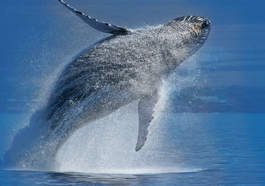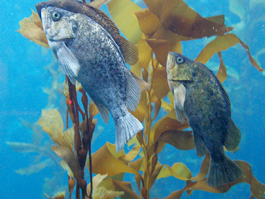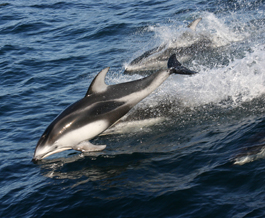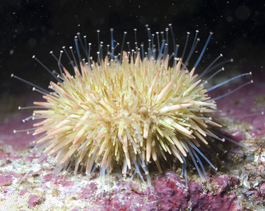home | metro silicon valley index | features | silicon valley | feature story

Chill Factor
Cooling currents have sparked a huge comeback for life in the Monterey Bay this year. But scientists say global warming could put an end to the extraordinary conditions that breathe new life into local waters.
By Steve Hahn
The water splashes up in all directions as a huge humpback whale hits the water just a few hundred yards off the boat's bow. An amazed crowd jockeys for position as they eagerly await the whale's next appearance. There is tense silence on this small boat run by the Monterey Bay Whale Watch as it idles over one of the largest submarine canyons in the world. Finally, the whale's tail emerges, indicating it is going deeper into the canyon to hunt the schools of anchovies that are in abundant supply this year.
This humpback whale is not alone in its search for food in the Monterey Bay. Nancy Black, a marine biologist working with Monterey Bay Whale Watch, estimates there could be as many as 60 humpbacks feeding in the bay this summer. That's a huge improvement over the fewer than 40 of the whales recorded each year over the past eight years.
A smaller pod of blue whales, one of earth's largest and hungriest creatures, have also made the trip from Central America up to the Monterey Bay this summer to feed on the tons of krill they need to eat every day to survive. Black hasn't even seen a blue whale in these parts for at least three years, but this year she's recorded at least two. She has been marking down her sightings every day and comparing them to historical data. The results that have come back indicate this could be one of the best years for whale watching—not to mention the wider bay ecosystem—in the last decade.
"We individually identify the whales by the markings on the underside of the tail flukes and contribute those identifications to Cascadia Research, which compiles all the photos and determines a population estimate for these whales each year," says Black. "I'd say this is the best year for the past seven or eight years."
The fact that more and more of these top-level marine predators are migrating to the Monterey Bay this summer is not just a boon for ecotourism, it's also an indication that the near-shore marine ecosystem is recovering from a frightening three year lull that devastated fish, seabird and marine mammal populations.

Steve Lonhart/SIMON NOAA
I WANNA ROCKFISH: The incredible growth of kelp forests this year has led
to an explosion in the populations of Monterey Bay fixtures like rockfish.
Back to Life
The large and playful whales get the most attention from sightseeing humans, but it's actually a group of much smaller marine organisms that ultimately cause the whales to call Monterey Bay home for the summer. Phytoplankton, microscopic organisms that form the base of the marine food chain, don't put on much of a show, but their abundance this year has drawn huge schools of rockfish, massive flocks of seabirds, hundreds of dolphins and dozens of whales spread out for miles along the bay's famous submarine canyon.
Francisco Chavez has been studying these tiny but crucial organisms for the past 20 years at the Monterey Bay Aquarium Research Institute, and this is one of the best years he's seen in quite a while. The main reason for this is the strong winds that drive a process known as coastal upwelling, in which cold and nutrient-rich water lying about 60 meters below the surface is thrown to the top of the water column. Chavez describes this cold deep-sea water as the compost of the sea. Without it, phytoplankton growth is stymied and larger marine life has a hard time finding food. This was the situation from 2004 to 2006, when a lack of upwelling set off a great deal of hand wringing among marine biologists and fishing fleets. This year, however, Chavez has good news.
"In the 20-year record, 2008 was the coolest year we've seen in the bay," reports Chavez. "That cooler water is like compost—material has sunk there and degraded. So when you bring that compost to the surface and put it in contact with sun, you stimulate growth that the whales, porpoises and rockfish feed on."
A larger marine process known as the California current is also helping funnel nutrients to the Monterey Bay this year. The current is located about 200 kilometers offshore and stretches from the Gulf of Alaska to Baja California. William Sydeman, who holds a Ph.D. in ecology, has been studying the effect of the California current on the marine environment for the past 15 years. He notes that from 2004 to 2006 this current was extremely weak. When the weak current was coupled with a lack of upwelling, there were a number of seabird and salmon deaths. This year, the current seems to have picked up steam, meaning that nutrients stored in cool water off Alaska and Canada are being swept down the coast. As the current makes its way south, nutrients are spread out along California's coastal ecosystems, including the Monterey Bay, further fertilizing areas already seeing robust production due to strong upwelling closer to the shore.
"Sometimes the current starts further south than in other years, but this year it's starting closer to Prince William Sound [the northern most point in the Gulf of Alaska]," says Sydeman. "Everything south of that bifurcation zone gets swept southward. So all this stuff from the Gulf of Alaska has been swept down here and it makes for a very productive system."

Chad King/SIMON NOAA
JUMP IN JUMPIN': An abundance of microscopic phytoplankton has
drawn hundreds of dolphin, thanks to the phenomenon of upwelling.
Scientists say climate change could limit upwelling in the future.
Warming Threat
This upwelling process, which has provided the bedrock of the marine ecosystem for centuries, may be threatened by global climate change, according to local scientists. Sydeman and other researchers have used recent El Niņo events as a case study of what effect increased temperatures could have on the ocean over the next century. One of the essential ingredients of successful upwelling—cold, nutrient-rich water flowing just below the surface—could be threatened if global climate projections become reality, explains Sydeman.
"You can have upwelling, and it can be worthless. Good upwelling happens when that cold, nutrient-rich water is thrown above the thermocline [the warm surface layer of the ocean] where sun can reach the nutrients and stimulate growth of phytoplankton," explains Sydeman. "But during El Niņo, or in the case of an ocean warming trend, the thermocline gets deeper. In other words, there is no cold layer—it's all just warm water. So you can have upwelling, but it's just mixing warm water with more warm water. So it doesn't do anything in terms of food webs."
The second essential ingredient for successful upwelling—strong offshore winds along the coast—could also be altered in unpredictable ways that could leave marine life struggling to adapt in time, according to Mark Carr, a professor of evolutionary biology and ecology at UCSC.
"The coastal winds tend to move the surface waters offshore, and when those surface waters get displaced, this cold nutrient-rich water that comes up from depth replaces them," says Carr. "Where the winds occur, how strong they are and in what direction they blow is largely driven by temperature differences over the ocean and on land. With climate change, the predictions are that those differences are going to vary geographically. So the effect of this temperature differential on the wind patterns could impact the location and strength of the upwelling."

Chad King/SIMON NOAA
BOTTOM FEEDER: Unusually strong kelp growth also benefits the lower end of the bay's food chain, such as sea urchins.
Chain of Food
The effect of this year's strong current, however, is already being seen in the kelp forests that hug the coast along the Monterey Bay. Mark Carr has been surveying rockfish populations in the kelp forest over the past decade. His team sets up fish collectors in four key locations along the coastal kelp every year. During the troubled 2005–2007 period, there were never more than two fish on a collector—sometimes there were none. This year, his team has found 30 to 40 rockfish per collector. Carr explains that the growth of the kelp forests this year bodes well not just for rockfish populations but also for a whole host of invertebrates that inhabit the deep-sea canyon further offshore.
"The upwelled water is nutrient rich and fertilizes the kelp forests along the coasts," explains Carr. "The kelp is going to grow and grow this year. That kelp production of course fuels food webs in the kelp beds, but the kelp is also carried offshore where it gets torn up and falls into the canyon and deep sea reefs. So it's a form of nutrient that abalone, sea urchin and other invertebrates in the canyon feed on."
The abundance of rockfish this summer also presages strong growth among other marine life, according to Carr.
"When these juvenile rockfish start settling out in the kelp beds and on the deeper reefs, there are lots of other fish that feed on them, including older rockfish," says Carr. "Also, the seabirds feed off the juvenile rockfish sometimes. That's very important in determining how well the seabird populations are reproducing."
When the marine ecosystems off the California coast went into steep decline around 2005, the seabirds were among the hardest hit. Fewer rockfish and krill [small, shrimplike organisms] meant less food for young birds nesting in the Farallon Islands, where birds seen above Monterey Bay raise their young. Sydeman was surveying the nests of the Cassin's auklet, a small, dark-feathered bird that frequently makes its way south to Monterey, when something startling happened. The auklets abandoned their colonies and didn't produce any young. That had never happened before in 35 years of recordkeeping. In 2006, the birds again failed to produce any offspring due to the lack of food. Then in 2007, things began looking better—37 percent of the pairs produced offspring. This year, 75 to 80 percent are projected to breed, although it's too early to tell exactly. Since auklets can survive for up to five years, two years without breeding doesn't spell instant doom for the colony. However, the populations were already in decline over the long term, so they were deeply affected by those missed breeding opportunities as older birds died off and weren't replaced by young.
Luckily, the burst of productivity in the marine environment over the last two years came just in time.
"This is the second year of the upswing, but it started at such a bad place that it's just slowly recovering," says Sydeman. "The problem is the auklet populations on the Farallones were already sliding. They went from 100,000 in the early '70s to 25,000 in the early 2000s. It was recovering, but then in 2005–06 the population crashed to 15,000."
This year's healthy breeding cycle should help pull the auklets back from this steep decline, but Sydeman is still cautious.
"I don't think we should get overly excited about one good year that comes in and interrupts what are generally poor conditions," says Sydeman. "It's all right to feel good about this news, but you have to put it in the right context."
San Francisco.com Real Estate
Moving to the Bay Area just became easy. Let San Francisco.com show you all the homes currently for sale.
San Jose.com Real Estate
Relocating to San Jose or Silicon Valley? Let San Jose.com introduce you to some expert area real estate agents.
Carr agrees that the productivity of the bay this year doesn't mean it's time to declare all problems in the marine environment solved, but he does see it as a refreshing sign that the declines seen in the middle of the decade weren't permanent.
"It's too early to say whether or not its going to be a gangbuster year, but certainly it will be better than the last few years," says Carr. "It's a pretty variable oceanographic pattern."
Send a letter to the editor about this story.
|
|
|
|
|
|
